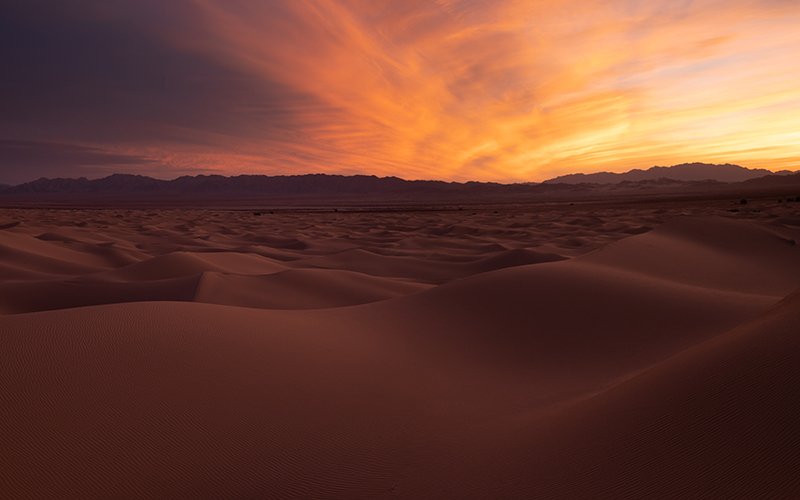Celebrating 30 Years of Protection: The California Desert Protection Act and The Wildlands Conservancy’s Enduring Legacy
Cadiz Dunes, Mojave Trails National Monument / photo by Jack Thompson
As October 31, 2024 approaches, we celebrate the 30th anniversary of a monumental moment in the history of conservation: the signing of the California Desert Protection Act (CDPA) of 1994. This landmark bill, authored by the late U.S. Senator Dianne Feinstein, not only introduced safeguards for vast expanses of the California desert, but also shaped the trajectory of environmental advocacy across the state. For The Wildlands Conservancy, the CDPA was more than just a legal victory — it was the foundation upon which decades of conservation efforts have been built. As a leading advocate for desert protection, Wildlands plays an instrumental role in ensuring that the Mojave Desert, along with other crucial ecosystems, remain a sanctuary for future generations.
The California Desert Protection Act: A Turning Point for Conservation
Signed into law by President Bill Clinton on October 31,1994, the CDPA is one of the most significant conservation bills in U.S. history. It transformed the landscape of environmental protection in California by establishing Joshua Tree and Death Valley as National Parks and creating the Mojave National Preserve, a 1.6 million-acre stretch of protected wilderness. The CDPA also provided official wilderness protections to over 70 unique desert locations, ensuring the long-term preservation of these ecologically unique and fragile environments.
These ecosystems are home to some of the most resilient species, including the desert tortoise and bighorn sheep, which continue to exist in the harsh environments of the high Mojave Desert. The CDPA not only preserved these lands, but also set a precedent for future conservation efforts that would safeguard biodiversity and protect recreational opportunities for the public.
The Wildlands Conservancy’s Role in Desert Conservation
The Wildlands Conservancy has long been at the forefront of desert protection, recognizing that the desert is more than just barren land — it is a living, breathing ecosystem filled with beauty, silence, and resilience. Wildlands’ dedication to conserving the California desert began after the passage of the CDPA, embarking on a series of bold initiatives to permanently protect these treasured landscapes.
From 1999 to 2004, Wildlands made history by purchasing 587,000 acres of fragmented desert land threatened by development. In what would become the largest conservation land donation in U.S. history, these lands were transferred to the U.S. Department of the Interior for permanent protection. This monumental achievement was not only a testament to Wildlands dedication, but also a vital step in ensuring the continued protection of the California desert’s natural beauty and biodiversity.
“The fate of the California desert was at a tipping point in the 1980s when development and uncontrolled off-road vehicle use threatened to fragment and destroy its biological and recreational treasures. Then came the California Desert Protection Act of 1994, a turning point for conservation, which paved the way for The Wildlands Conservancy to step in with bold vision and determination, securing nearly a thousand square miles of this irreplaceable landscape for future generations.”
Monumental Achievements: Mojave Trails and Sand to Snow
The impact of the CDPA did not stop in 1994. With relentless dedication, Wildlands continued to advocate for the Mojave Desert, working alongside the late U.S. Senator Dianne Feinstein for nearly two decades to ensure further protections. These efforts culminated in the creation of two national monuments: the 1.6 million-acre Mojave Trails National Monument and the Sand to Snow National Monument.
The Mojave Trails National Monument, created in 2016, bridges protected lands between the Mojave National Preserve and Joshua Tree National Park, creating a vast, contiguous landscape of preserved desert. The Sand to Snow National Monument, on the other hand, safeguards a unique transition zone from the low desert to the towering peaks of the San Bernardino Mountains. These monuments exemplify Wildlands’ enduring commitment to the California desert and to ensuring that future generations can experience its awe-inspiring landscapes.
Looking to the Future
As we celebrate the 30th anniversary of the CDPA, it’s important to recognize that the work of conservation is never truly finished. Wildlands remains committed to protecting California’s deserts, forests, and other wild landscapes. As threats like climate change, development, and habitat fragmentation persist, Wildlands' mission is more critical than ever.
The California Desert Protection Act of 1994 was not only a landmark piece of legislation in U.S. conservation history— it was a promise to protect a delicate and irreplaceable part of the world. For Wildlands, it served as both a challenge and an opportunity, one that the organization has embraced wholeheartedly, ensuring that these wild spaces remain untamed, wild, and free for all.
As we look to the future, we are reminded that the spirit of the CDPA lives on in every acre of desert preserved, every species protected, and every person who finds solace in these vast, quiet landscapes. The work of The Wildlands Conservancy continues, grounded in the belief that protecting our wild places is not just an environmental necessity — it is a moral imperative.

